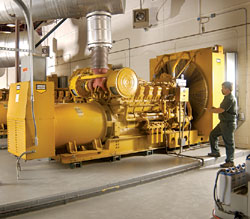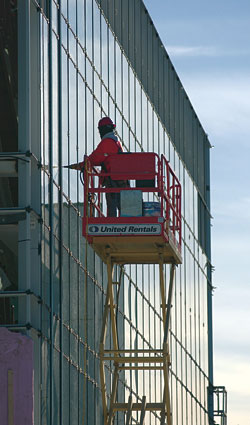Construction project is taking account of the environment
"With construction costs of more than $200 million, Project for Progress is a pretty darn unusual project," says Rick Nothnagel, vice president of facilities at Dartmouth-Hitchcock.
He's right on several counts about the major addition and renovation project now well under way at DHMC. There are only a handful of hospital expansions of this size today—and even fewer so thoroughly taking the environment into account. Such a project has the potential to disrupt wildlife habitats and ecosystems. But DHMC is taking steps, inside and outside the facility, to minimize its impact.
While building a new employee parking lot, for example, DHMC went above and beyond state regulations to preserve wetlands, which are valuable because they filter water, reduce flood risks, and provide fish and wildlife habitats. The 956-car lot was designed to incorporate both existing and replacement wetlands. In between rows of parked cars, irregularly shaped buffer islands of native plants, grasses, and trees make use of natural water on the property.
Species: And while some plants were added to the new lot, some were taken away. Invasive species, such as purple loosestrife, can grow rapidly, colonizing disturbed areas such as construction sites. DHMC worked with city officials in Lebanon, N.H., to identify three invasive species—loosestrife, glossy buckthorn, and barberry—and remove them in an environmentally sound way. Barberry, for example, was chipped and then burned to produce energy.
Behind the facility's cinderblock walls lie more conservation features. All building operations are completely automated via computer. "We know we're running everything at the optimal level," says Nothnagel. DHMC has five different-sized chiller-compressors that run the refrigeration and central air-conditioning equipment, each with a different level of efficiency. "Some operate better at a lower capacity, while others work better at full capacity. We're constantly analyzing the load and running a combination of equipment that gives us the most energy- efficient operation."

|
|
Both inside (above) and outside (below),
DHMC's "Project for Progress" expansion
takes account of the environment. |

|
Other features include highefficiency motors in the power plant and a new mall that is illuminated with skylights. There is also natural lighting on the top floor of the addition to the Rubin Building; there, Cancer Center administrative offices along the building's perimeter on Level 8 don't have a solid wall facing the interior hallway; instead, an 18- inch glass strip at the top allows natural light to filter into the center of the building.
"From the very beginning, DHMC was designed to be energy efficient. We were able to 'go green' with a new facility," says Nothnagel. In fact, the original DHMC building, which opened in 1991, won two awards for its best practices: the 1994 National Energy Award for Utility Technology from the U.S. Department of Energy and the 1994 Governor's Energy Award. "Project for Progress has continued these same design principles," Nothnagel concludes.
If you would like to offer any feedback about this article, we would welcome getting your comments at DartMed@Dartmouth.edu.
